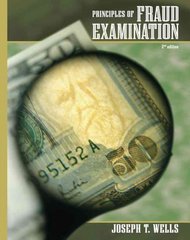Question
In a February 19, 2004, press release, the Securities and Exchange Commission described a number of fraudulent transactions that Enron executives concocted in an effort
In a February 19, 2004, press release, the Securities and Exchange Commission described a number
of fraudulent transactions that Enron executives concocted in an effort to meet the companys
financial targets. One particularly well-known scheme is called the Nigerian barge transaction.
According to court documents, Enron arranged to sell three electricity-generating power barges
moored off the coast of Nigeria. The buyer was the investment banking firm of Merrill Lynch.
Although Enron reported this transaction as a sale in its income statement, it turns out this was
no ordinary sale. Merrill Lynch didnt really want the barges and had only agreed to buy them
because Enron guaranteed, in a secret side-deal, that it would arrange for the barges to be bought
back from Merrill Lynch within six months of the initial transaction. In addition, Enron promised
to pay Merrill Lynch a hefty fee for doing the deal. In an interview on National Public Radio on
August 17, 2002, Michigan Senator Carl Levin declared, the case of the Nigerian barge transaction
was, by any definition, a loan.
Required:
1. Discuss whether the Nigerian barge transaction should have been considered a loan rather
than a sale. As part of your discussion, consider the following questions. Doesnt the Merrill
Lynch payment to Enron at the time of the initial transaction automatically make it a sale,
not a loan? What aspects of the transaction are similar to a loan? Which aspects suggest revenue
has not been earned by Enron?
2. The income statement effect of recording the transaction as a sale rather than a loan is fairly
clear: Enron was able to boost its revenues and net income. What is somewhat less obvious,
but nearly as important, are the effects on the statement of cash flows. Describe how including
the transaction with sales of other Enron products, rather than as a loan, would change
the statement of cash flows.
3. How would the difference in the statement of cash flows (described in your response to
requirement 2) affect financial statement users?
Step by Step Solution
There are 3 Steps involved in it
Step: 1

Get Instant Access to Expert-Tailored Solutions
See step-by-step solutions with expert insights and AI powered tools for academic success
Step: 2

Step: 3

Ace Your Homework with AI
Get the answers you need in no time with our AI-driven, step-by-step assistance
Get Started


